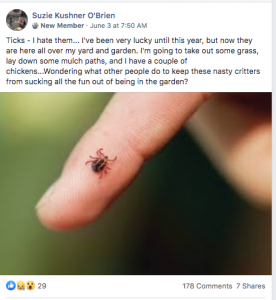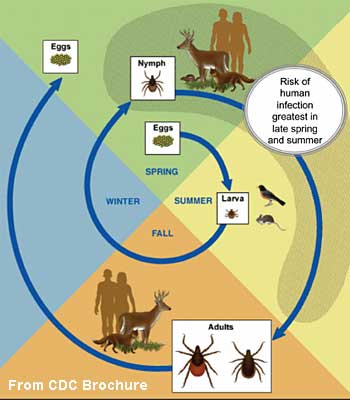
I wear tick-repellant clothing when I figure on the basis of habitat, area and season that I could be highly exposed to lyme-carrying ticks. A few years back – when I made this pic and the comment “4 reasons for cross-border shopping” – this clothing was not available in Canada. It is now, e.g. at Marks.
The first line of defence is to know where and when one could get bitten by ticks carrying Lyme disease and to take precautionary measures accordingly.
I have been concerned about ticks/lyme for some time. I maintained a website under the domain name noticks.ca for several years, it is still available at http://versicolor.ca/noticks/ It contains info and links to info about preventing tick bites, and about the life history of the black-legged tick. It has not been updated since mid-2016; more recent info is given on this page.
For a period I campaigned to have tick-repellent, permethrin-treated clothing available in Canada, also picaridin (Icardin) based personal insecticides. The former just happened (2018)* but Icaridin based personal insect repellents have been available for a few years. They began to appear in local drugstores in 2017 – at least that’s when I first saw them. They are as effective as or more effective than DEET based insect repellents but do not have the smell of DEET, nor do they interact with (and damage) plastics and some synthetic materials as DEET can do.
*View Permethrin-treated clothing arrives in Canada, posted on rockiestrailguide.com, June 14, 2018; also This Post
| Life Cycle of Lime Disease Ticks Extract From CDC Brochure: Knowing the complex life cycle of the ticks that transmit Lyme disease bacteria can help in understanding the risk of getting the disease and how to prevent it. The complete life cycle of Ixodes ticks requires 2 years. Tick eggs are laid in the spring, and hatch as larvae in the summer. Larvae feed on mice, birds, and other small animals in the summer and early fall. The larvae may become infected with Lyme disease bacteria when feeding on these animals. Once a tick becomes infected, it stays infected for the rest of its life and can transmit the bacteria to other hosts. After this initial feeding, the larvae usually become inactive until the following spring, when they change into nymphs. Nymphs seek blood meals in order to fuel their growth into adults. Nymphs feed on small rodents, birds, and other small mammals in late spring and early summer. Nymphs will also feed on humans, and if previously infected with Lyme disease bacteria, they can transmit the disease to humans. Nymphs molt into adult ticks in the fall. In the fall and early spring, adult ticks feed and mate on large animals, such as deer. Adult female ticks will |
A few Links
NOVA SCOTIA
Nova Scotia pharmacists can now treat tick bites
Vernon Ramesar · CBC News. Aug 14, 2021. Antibiotics can be prescribed in certain cases
Andrew Hebda on Ticks in Nova Scotia (YouTube Video)
Presentation to NatureNS May 29, 2021. 43 minutes. On different species of ticks, their origins, infection with Lyme disease, their spread, biology, and ways to reduce risk of exposure. Andrew recently retired from the NS Museum where he was Curator of Zoology
Nova Scotia a hotbed for ticks, veterinarians urge pet owners to take precautions
www.trurodaily.com . July 18, 2019
NS Lyme Disease Counts by Zone 2016
NS Government. Confirmed cases 2016 Central 4.9/100,000; Eastern 0/100,000, Northern 4.1/100,000, Western 66.9/100,000
Also available: Lyme Disease Counts by Age Group 2016 and Lyme Disease Counts by Sex 2016
Thousands more people suffer from Lyme disease than reported: study
Andrew Rankin in the Chronicle Herald Oct 19, 2018. “The number of people with Lyme disease in Nova Scotia could be as much as 30 times higher than government statistics show, says a new national peer-reviewed report co-authored by a Mount Allison University tick expert.” View research paper, Under-Detection of Lyme Disease in Canada – by Vett K. Lloyd and Ralph G. Hawkins in Healthcare Oct 15, 2018.
Ticks are really digging in on the South Shore
ANDREW RANKIN THE CHRONICLE HERALD THE CHRONICLE HERALD
Published May 19, 2018 – 5:00am
Public health failing to address Lyme disease crisis, says author
Andrew Rankin for the Chronicle Herald, June 3, 2018
In the tick of it
Sandra Phinney in Saltscapes Living Healthy in Atlantic Canada, Spring/Summer 2018. Local context, researchers cited.
Nova Scotia’s top doctor sees no end to spread of Lyme disease
ANDREW RANKIN THE CHRONICLE HERALD September 8, 2018
OPINION: Lyme disease tunnel vision plagues provincial authorities
Jane Bailey in the Chronicle Herald, Nov 3, 2018
Statement for Managing Lyme Disease in Nova Scotia
Infectious Diseases Expert Group (IDEG), Department of Health and Wellness
2018
| Lyme disease cases per 100,000 people in 2016 by province NL 0.2 PEI: 2.7 NS: 34.4 NB: 1.5 Que: 2.1 Ont: 2.7 Man 3.9 Sask: 0.1 Alta: 0.2 BC: 0.8 The territories: 0 The figures are presented on a map of Canada, page 17 in the July 2018 print issue of MacLeans Magazine. |
RECOGNIZING TICKS, PERSONAL PESTICIDES ETC
How big are they? See pic at http://www.infectionlandscapes.org to view ticks on a finger: engorged and not engorged; nymph and adult
The Anatomy of a Tick
American Lyme Disease Foundation Video
How to remove a (Black-legged) Tick properly
American Lyme Disease Foundation Video
The Most Effective Tick Repellents for Humans (and Dogs), According to Science
By Maxine Builder in NY Magazine, May 8, 2018
LYME DISEASE: What you need to know
Brochure by US Center for Disease Control and Prevention. How it’s spread, Where it’s found, How it’s prevented, How it’s diagnosed, How it’s treated
New study confirms efficacy of permethrin-treated clothing against tick bites
Healio . Infectious Disease News, June 3, 2018
Maritime Noon Interview Phone-in on Fighting off the Biting Insects of Summer
July 25, 2019, interview with Steve Scofield, an expert on deterrents to mosquitoes, ticks etc. A lot of discussion on use of permethrin-treated clothing. Begins at 13:05 mins
Why patients are caught in the battle over treating chronic Lyme disease
CBC Radio · Posted: Sep 20, 2019 “Medical experts and guidelines divided over chronic or post-treatment Lyme disease syndrome”
LAND AND WILDLIFE MANAGEMENT, TICK ECOLOGY
UMaine researchers get $1.17M to help protect forest workers from tick-borne illnesses
Mainebiz, July 19, 2018
The team plans to conduct applied ecological research to understand the impact of timber harvesting on risk of exposure to tick-borne diseases…By integrating natural and social science research, extension and education, the team aims to develop and test adaptive land management practices to protect private forest owners, foresters and loggers against exposure to tick-borne diseases…”Our forest management decisions can have dramatic effects on the abundance and behavior of vertebrate hosts of tick-borne pathogens and also the abiotic conditions that influence tick survival during the large proportion of the tick life cycle spent off-host,” Gardner says. “Because our state is dominated by forest land cover, it is important that Mainers understand the numerous ecosystem services provided by healthy forests, including buffering zoonotic disease transmission.”
Chief medical officer: Don’t use pesticides to protect property from ticks
Andrew Rankin for Chronicle Herald, July 12, 2018. “While the province’s tick population continues to balloon, the province’s chief medical officer of health is advising homeowners against using pesticides to protect their property from the disease-carrying parasites. Dr. Robert Strang’s recommendation comes in response to a North American pest control company launching a residential pesticide spraying program recently in Nova Scotia.”
In relation to the above article and use of deer bait stations, see The effectiveness of permethrin-treated deer stations for control of the Lyme disease vector Ixodes scapularis on Cape Cod and the islands: a five-year experiment
Jason S Grear et al. 2014 Parasites and Vectors. 2014; 7: 292. “Relative to controls, blacklegged tick abundance at treated sites was reduced by approximately 8.4%, which is considerably less than in previous 4-poster studies. …The relatively modest effect of 4-posters on tick abundance in this five-year experiment, compared to larger effects seen in other studies, can possibly be explained by landscape characteristics, deer density and vertebrate host community composition in our study area, and the density of 4-poster stations we deployed. An important management implication is that the role of deer in the Lyme disease system may be more complicated than previously expected. It is important to weigh this possibility against concerns from the wildlife management community about the effects of wildlife provisioning and increased social contact between wildlife visitors at the 4-poster stations (e.g., wildlife disease transmission). This means that 4-posters deserve further study, experimental application, and refinement, but do not represent a low cost ‘silver bullet’ in the control of Lyme disease except perhaps under specific circumstances that remain to be identified. This is unsurprising given the complexity of the Lyme disease ecological system. 4-posters should be considered part of a broader suite of strategies, the most sustainable of which in the long term will embrace the strong linkages between ecological health and human disease risk and will support the differing mandates of environmental stewardship, wildlife management, and public health organizations.”
Evaluation of the SELECT Tick Control System (TCS), a Host-Targeted Bait Box, to Reduce Exposure to Ixodes scapularis (Acari: Ixodidae) in a Lyme Disease Endemic Area of New Jersey
Terry L. Schulze et al., 2017. Journal of Medical Entomology, Volume 54, Issue 4, 1 July 2017, Pages 1019–1024. View Finally! A Way Homeowners Can Control Ticks That Spread Lyme Disease by Cynthia Wallentine 2017 for a popularreport on the above study.
Why finding a solution to control Lyme disease isn’t simple
PBS news, 2017. “The explosion of the deer population in suburbia and the rapid rise of Lyme disease are warning signs of an ecosystem out of balance. The hunt for solutions won’t be cheap, easy or fast.”
Forest ecology shapes Lyme disease risk in the eastern US
Science Daily, July 9, 2018 “In the eastern US, risk of contracting Lyme disease is higher in fragmented forests with high rodent densities and low numbers of resident fox, opossum, and raccoons. These are among the findings from an analysis of 19 years of data on the ecology of tick-borne disease in a forested landscape.” The scientific paper cited: Richard S. Ostfeld et al. 2018 Tick-borne disease risk in a forest food web. Ecology 99(7), 2018, pp. 1562–1573.
Deer, predators, and the emergence of Lyme disease
Taal Levi et al., 2012 In PNAS 109 (27) 10942-10947 “The continuing and rapid increase in Lyme disease over the past two decades, long after the recolonization of deer, suggests that other factors, including changes in the ecology of small-mammal hosts may be responsible for the continuing emergence of Lyme disease… These results suggest that changes in predator communities may have cascading impacts that facilitate the emergence of zoonotic diseases, the vast majority of which rely on hosts that occupy low trophic levels.”
Ticks rising
On aeon.ca, Apr 2, 2018. “In a warming world, ticks thrive in more places than ever before, making Lyme disease the first epidemic of climate change”
Governor Cuomo Announces Lyme and Tick-Borne Disease Control Plan
Albany, NY, May 15, 2018 Thx JMS
Tale of the Tick: How Lyme Disease is Expanding Northward
by Dave Mance III in Northern Woodlands, March 1, 2008. A very readable description of the life cycle of the black-legged tick and factors affecting its abundance and the occurrence of the microorganism that causes Lyme disease.
Tick Management Handbook (PDF)
“An integrated guide for homeowners, pest control operators, and public health officials for the prevention of tick-associated disease.” (2004)
Managing Ticks on Your Property (PDF).
Prepared by Kirby C. Stafford III, Ph.D. (March 2005) Shorter version of the doc above. The Connecticut Agricultural Exp eriment Station. Unfortunately some of the products suggested are NOT available in Canada.
Multiflora rose invasion amplifies prevalence of Lyme disease pathogen, but not necessarily Lyme disease risk
Solny A. Adalsteinsson et al., 2018. Parasites & Vectors 2018, 11:54
Ticks aren’t just a problem for summer anymore: Experts
Elizabeth Di Filippo,Yahoo Canada Dec 14, 2018.
Although typically associated with spring and summer, Dr. Vett Lloyd, one of Canada’s most prominent tick experts says the insects are still being found on humans and animals.
“Most people expect that when it’s cold, ticks go away, but they don’t,” Lloyd told CTV News. “The moment we have a warm day, there’s a little bit of sun on the snow, [it] melts and they’re hungry and they’re ready to go, all you need to do or your dog needs to do is walk by there and there and you can get a tick.”
Lloyd studies samples of ticks sent to her from areas of New Brunswick and Nova Scotia.
etick.ca
New (May 2019) Interactive Map/records of ticks in Canada.
Tick-tracking Project on iNaturalist
“Watch out for these nasty Arachnids, TICKS! They can carry multiple diseases transmitted to humans after they bite and their geographical distribution is rapidly changing. Help us gather geospatial data so researchers, states, and concerned citizens can share the information and move forward actions to help fight disease.”
Created by:kmorse2 – September 5, 2018
 An informative discussion about ticks on residential properties on Facebook
An informative discussion about ticks on residential properties on Facebook
On East Coast Gardening, Nova Scotia (Public Facebook Page), posted June 3, 2020
New online tool helps Nova Scotians manage tick risk
Moira Donovan · CBC News Aug 3, 2020
Could forest fragmentation be a factor in the high incidence of blacklegged tick/lyme in Nova Scotia?
Post on NSFN Jun 16, 2018 “The evidence is sufficient that I breathe more easily when traversing larger patches of older forest, and I am more on guard for blacklegged ticks/lyme when I am in smaller patches or in and out of clearcuts.”
Cats and cars help scientists study Lyme disease
Mt. A. Univ. Jan 28, 2022 Study from Mount Allison University researchers uses citizen science to find a new source of Lyme disease bacteria in New Brunswick mice
UMaine and Maine Medical Center study illustrates how Lyme disease-causing ticks have increased in Maine
Bangor Daily News “Tracking the types of ticks that plague Maine helps scientists predict which tick-borne pathogens might become a problem. New research shows that blacklegged ticks have been increasing in abundance in a Midcoast forest over the past 30 years — and bringing more Lyme disease with it.”

